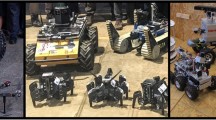Abstract
After the 2004 earthquake in Japan’sNiigata Prefecture, there were many difficulties finding the victims. The earthquake caused a wired network disconnection. In addition, fixed-phone and cell-phone service systems crashed due to the rapid increase in the volume of communications. The systems’ collapse was due to the large number of users who were worried about the safety of their relatives. The same situation happened during Hurricane Katrina in the USA. Reflecting on these situations, the Japanese Ministry of Internal Affairs and Communications is trying to adopt several methods to correct these communications problems. Although these methods have not been disclosed precisely yet, we think that a predominant goal of one of the methods is most likely to find victims using RFIDs (Radio Frequency Identification) with computer sensors. To do this, the RFID method would have to be incorporated in the following ways: 1) by scattering sensor devices from helicopters when a large-scale disaster such as an earthquake occurs, 2) by making RFIDs self-organized into a network, and 3) by making the self-organized network pinpoint the position of victims. A certain amount of field-testing may be necessary to confirm the effects of this plan. However, such testing requires a great amount of time and high costs. Therefore, we adopt an agent-based simulation for such a test. In this paper, we pay specific attention to a simple and assured algorithm for discovering victims using RFIDs. First, we explain our method to confirm the location of victims. Second, we explain our method for pinpointing the position of victims using trilateration. Finally, we present our simulation results.
Similar content being viewed by others
References
Toho, Y.: Restoration activity to Niigata Chuetsu earthquake and provision to large-scale disaster in the future. IEICE Transactions (Japanese Edition). 88(9), 751–754, 2005 (in Japanese)
Ministry of Internal Affairs and Communications, Japan.: Information and Communications in Japan; White Paper 2005. 263, 2005 (in Japanese)
Ministry of Internal Affairs and Communications, Japan.: Outlook for information and telecommunications policies. Information and Communications in Japan; White Paper 2006. 46–61, http://www.johotsusintokei.soumu.go.jp/whitepaper/eng/WP2006/chapter-3.pdf, 28 February 2008
Ministry of Internal Affairs and Communications, Japan.: Outlook for information and telecommunications policies. Information and Communications in Japan; White Paper 2007. 42–55, http://www.johotsusintokei.soumu.go.jp/whitepaper/eng/WP2007/chapter-3.pdf, 28 February 2008
Shah, S.F.A., Tewfik, A.H.: Performance analysis of directional beacon based position location algorithm for UWB systems. The Proceedings of Global Telecommunications Conference (GLOBECOM ’05. IEEE). 2409–2413, 2005
Anlauff, M., Sünbül, A.: Deploying localization services in wireless sensor networks. The Proceedings of the 24th International Conference on Distributed Computing Systems Workshops (ICDCSW’04). 782–787, 2004
Tseng, Y.C., Kuo, S.P., Lee, H.W., Huang, C.F.: Location tracking in a wireless sensor network by mobile agents and its data fusion strategies. The Computer Journal. 47(4), 448–460, 2004
Savvides, A., Park, H., Srivastava, M. B.: The bits and flops of the N-hop multilateration primitive for node localization problems. The Proceedings of the First ACM International Workshop on Sensor Networks and Applications (WSNA 2002). 112–121, 2002
Jayashree, L.S., Arumugam, S., Anusha, M., Hariny, A.B.: On the accuracy of centroid based multilateration procedure for location discovery in wireless sensor networks. The Proceedings of Wireless and Optical Communications Networks 2006 IFIP International Conference. 1–6, 2006
Langendoen, K., Reijers, N.: Distributed localization in wireless sensor networks: a quantitative comparison. Computer Networks. 43(4), 499–518, 2003
Sichitiu, M. L., Ramadurai, V., Peddabachagari, P.: Simple algorithm for outdoor localization of wireless sensor networks with inaccurate range measurements. The Proceedings of International Conference on Wireless Networks. 300–305, 2003
Tokyo Metropolitan Government, Japan.: Press release of Tokyo Metropolitan Government, 18 January 2006, http://www.metro.tokyo.jp/INET/OSHIRASE/2006/01/20g1j300.htm, 28 February 2008 (in Japanese)
Author information
Authors and Affiliations
Corresponding authors
Rights and permissions
About this article
Cite this article
Daito, M., Tanida, N. Agent-based simulation approach for disaster rescue using active RFID. Rev Socionetwork Strat 1, 23–39 (2008). https://doi.org/10.1007/BF02981635
Received:
Accepted:
Issue Date:
DOI: https://doi.org/10.1007/BF02981635




